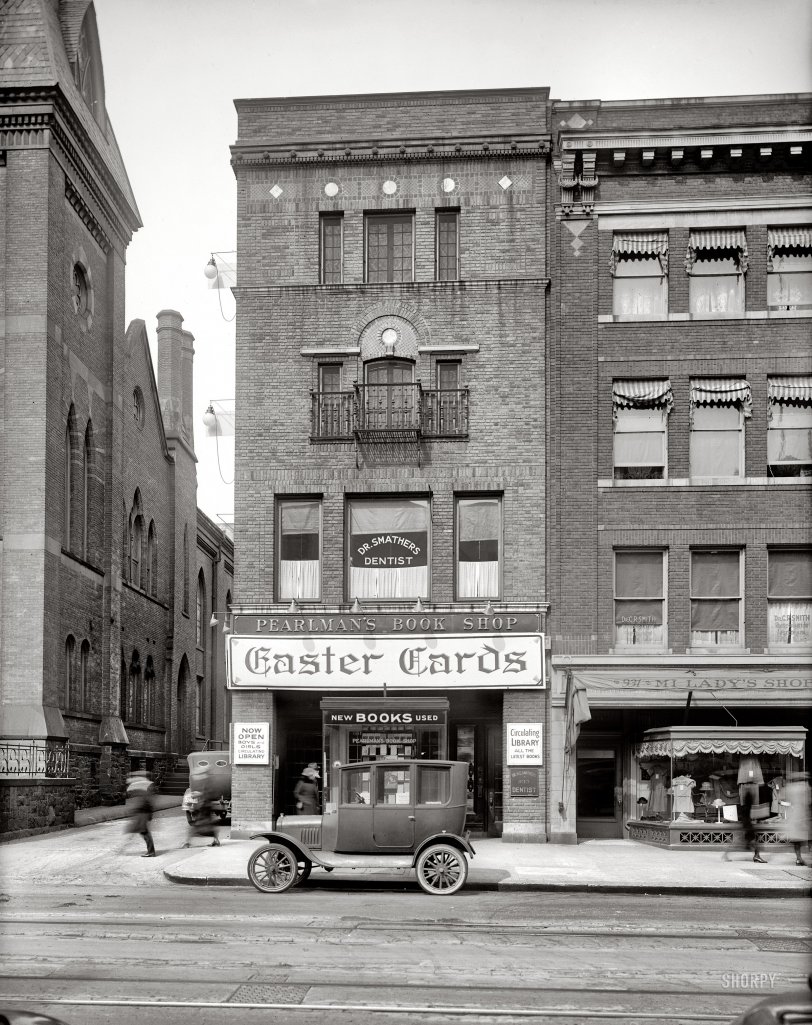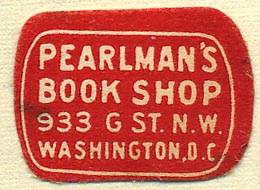


Framed or unframed, desk size to sofa size, printed by us in Arizona and Alabama since 2007. Explore now.
Shorpy is funded by you. Patreon contributors get an ad-free experience.
Learn more.

- Baldwin 62303
- Baldwin VO-1000
- Cold
- No expense spared
- Tough Guys
- Lost in Toyland
- And without gloves
- If I were a blindfolded time traveler
- Smoke Consumer Also Cooks
- Oh that stove!
- Possibly still there?
- What?!?
- $100 Reward
- Freeze Frame
- Texas Flyer wanted
- Just a Year Too Soon
- WWII -- Replacing men with women at the railroad crossing.
- Yes, Icing
- You kids drive me nuts!
- NOT An Easy Job
- I wonder
- Just add window boxes
- Icing Platform?
- Indiana Harbor Belt abides
- Freezing haze
- Corrections (for those who care)
- C&NW at Nelson
- Fallen Flags
- A dangerous job made worse
- Water Stop
Print Emporium
Easter Greetings: 1922

Washington, D.C., circa 1922. "933 G Street N.W." Happy Easter from Pearlman's and Shorpy. National Photo Company Collection glass negative. View full size.
Two Pearlman's
There is another very probable explanation for the "No Branch Stores" signage. There were two Pearlman Book Stores in Washington at the time. Paul Pearlman (my grandfather) broke away from the family business and started his own store, in 1921 (we think). It became a Washington institution. The store in the photo is the original business operated by his father and brother.
[Below, from 1924, the first Washington Post ad for Paul Pearlman's bookstore. - Dave]

"No branch stores"
This was a very common phrase in retail advertising in the early part of the century, when chain stores were proliferating. It meant this is the only one, so you better come in.
Private lending libraries
You have to think of the history of public libraries in North America to understand why there were private lending libraries.
Until Andrew Carnegie began to fund the building of public libraries across North America, the only access to books for most people was either purchasing them (mail order most often) or borrowing them from a private lending library. Like a public library, you paid a fee to join and often a fee per book to borrow the books.
The 252-year-old Athenaeum, in Rhode Island, is one of the nation's oldest private lending libraries.
Even after public libraries came about, largely thanks to grants from the Carnegie funding of libraries, many people who could afford to borrowed from private libraries because their selection would often include more "popular literature" which many public libraries might not. As well, there was a definite class perception about public libraries. Because the poor who couldn't afford to join a private library were free to borrow from public libraries, there was the idea that books from the public library were unsanitary, an idea which private libraries often put about.
Many private libraries also catered to specific ethnic groups. Yiddish libraries, for instance.
There are still private lending libraries, though they are fewer and farther between than they once were.
Night Lights
There's probably a sign on the alley side of the building. Hence the lamps. And then the tenants in the upstairs apartments complained, and those shields went up.
One if by land?
Two if by alley? What do you suppose the pair of globe lamps were used for at the second and third stories at the left of the building? There are reflecting boards behind them so I would not expect them to be for illuminating the alley. They seem to be arranged for good visibility some distance away from the storefront. Any ideas?
Thoughts and questions
First of all, the car with the center door reminds me of a stagecoach. Is it any wonder that it is the least likely to be seen today?
Second, why would it be necessary to advertise that this business had no branch stores? The sign is prominently and permanently painted on the front window so it must have been important.
Finally, my most burning question. What was the reason for private circulating libraries? To offer things that public libraries didn't?
Stories above Stories
Any clue to what was on the third and fourth floors? A Lodge Hall; a small theater; a handball court?
Those nice-looking windows wouldn't admit much light.
[The upper floors were apartments. - Dave]
Ahhhh!
Ahhhh! A photograph from an age in which folks did not try to feel offended by the celebration of Christian holidays and their attendant paraphernalia. Happy Easter!
[And Shalom. The proprietor, G. David Pearlman, was Jewish. - Dave]
Can't read something in the window
Immediately below "Pearlman's Book Store" is:
NO BRA-- S--RES
No brain shares?
[All I will say is, NO BRANCH STORES. - Dave]
The imprimatur
of Pearlman. Courtesy of Donald Francis.

Literary Lions
I remember the private circulating libraries. They were usually in drug stores. They had mainly new romantic novels that were aimed the women who were probably their best customers. I had an aunt who used to rent them, at 5¢ a day (if I remember correctly). She would read 3 a week.
Circulating Library
Does this sort of thing still exist? My dad used to rent Perry Masons and Ellery Queens by the week from one. In those days our public library considered such works beneath them. Now, of course, nothing is too low for the public library.
To All Care
Have a blessed Easter today and every day.
Bunny hop
Who knew the Easter Bunny rode in a "Center Door" sedan?
Mi-T-Fine Masonry
This photo has so much going for it. The masonry on the buildings is a visual treat, the lovely window dressings in the dress shop, and the snappy little car at the curb. I'm quite sure the dentist's office looked similar to the one previously posted here. Pearlman's looks like a place to lose yourself for a while browsing used books. Happy Easter!
The Middle Way
Those center door cars must have been a pain in the neck, unless you wanted to get in the back seat.
Still a Library!
Pearlman's circulating library gave way to a somewhat larger version of the same thing--the Martin Luther King Jr. Memorial Library. The church on the left is the First Congregational Church; the building was replaced in the 1950s, and that building was razed for redevelopment in 2008--now a hole in the ground.
























On Shorpy:
Today’s Top 5